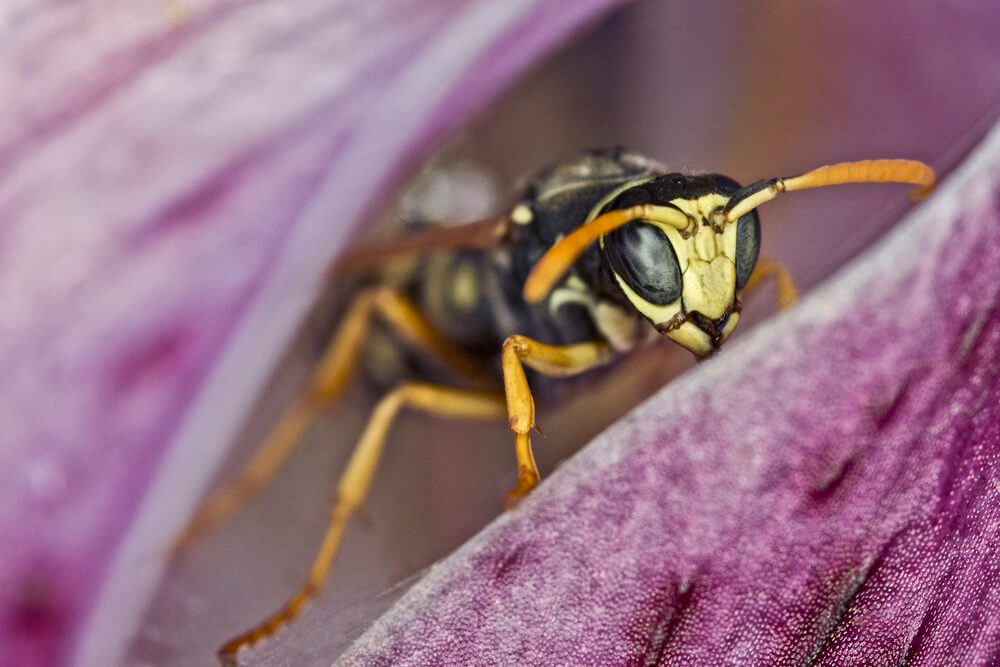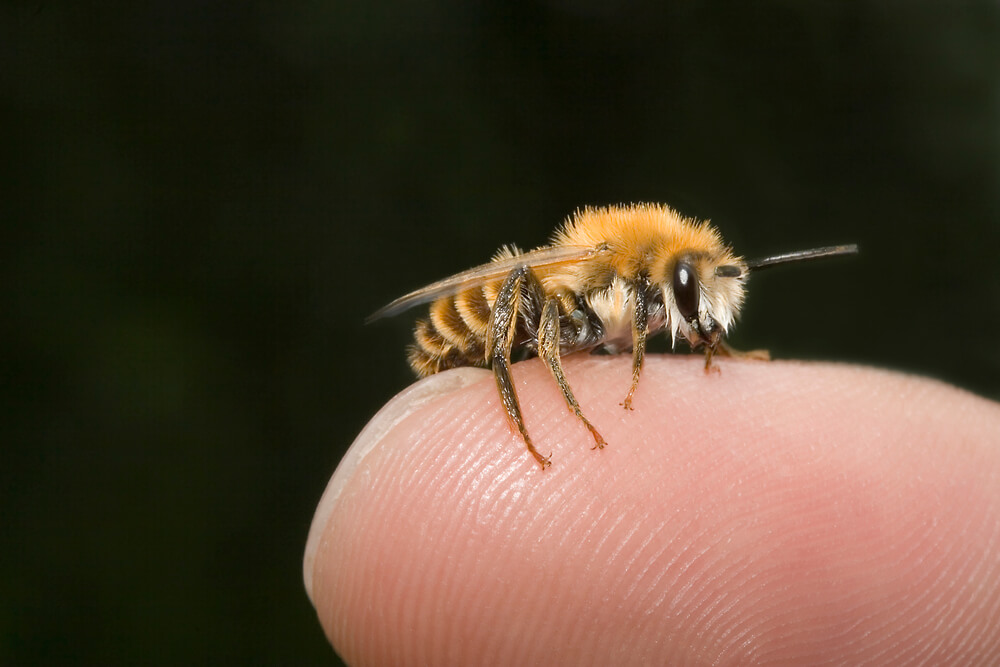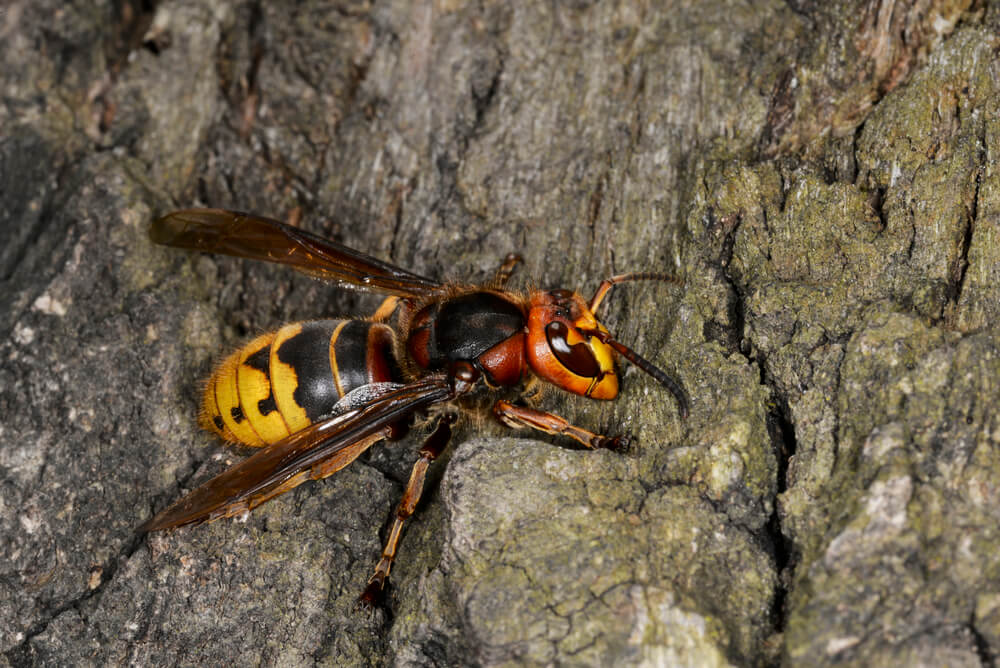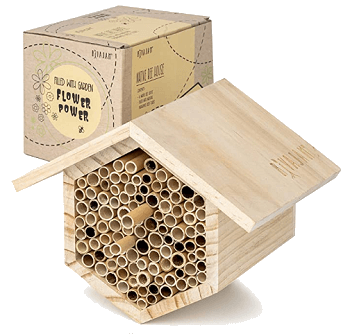Table of Contents:
What are Mason Bees?

Mason bees are small, gentle bees found throughout the world. There are over 130 species found in the United States alone.
More importantly?
These handy little bees are incredible pollinators. Just 250-300 mason bees can pollinate an entire acre of fruit crops like apples and cherries.
And if that isn’t enough:
It only takes about 400 mason bees to do the pollination work of 40,000 honeybees. For example, a honeybee usually needs to visit a flower 7-10 times before it’s fully pollinated.(1)
But mason bees?
They can pollinate a flower in a single visit.
This is because mason bees aren’t exactly elegant with their landings. They sort of belly flop into flowers which gets their fuzzy bodies covered in pollen. As a result, they spread pollen around generously.
This is why farmers are increasingly turning to mason bees to help with pollination. The little bees work well alongside honeybees in pollinating crops like blueberries, cherries, almonds, pears, and raspberries.
Now you might be asking…
How Do Mason Bees Lay Eggs?
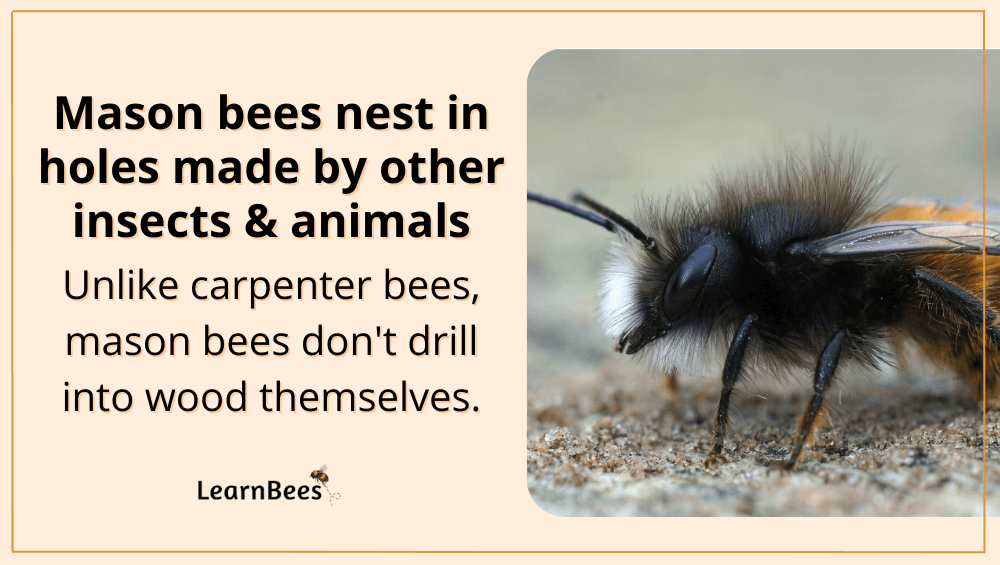
You guessed it.
Mason bees get their name from their nest-building technique. It reminds people of masonry work, which uses mortar to bind things like brick and stone together. As such, mason bees are often nicknamed ‘masonry bees’ or ‘mortar bees.’
But how do they do it?
Female mason bees start by finding holes created by other insects, birds, or even humans. Unlike carpenter bees, mason bees don’t drill into wood themselves.
Once the female mason bee has found a perfect spot, she begins the egg-laying process. This starts with her placing a ball of pollen and nectar deep inside the nest. Then, she lays her first egg on the pollen and nectar. This gives the larvae something to eat once they hatch.
And finally?
She seals the cell with a thin layer of mud. She repeats this egg-laying process until the entire length of the tunnel is used.
Here’s how it looks:
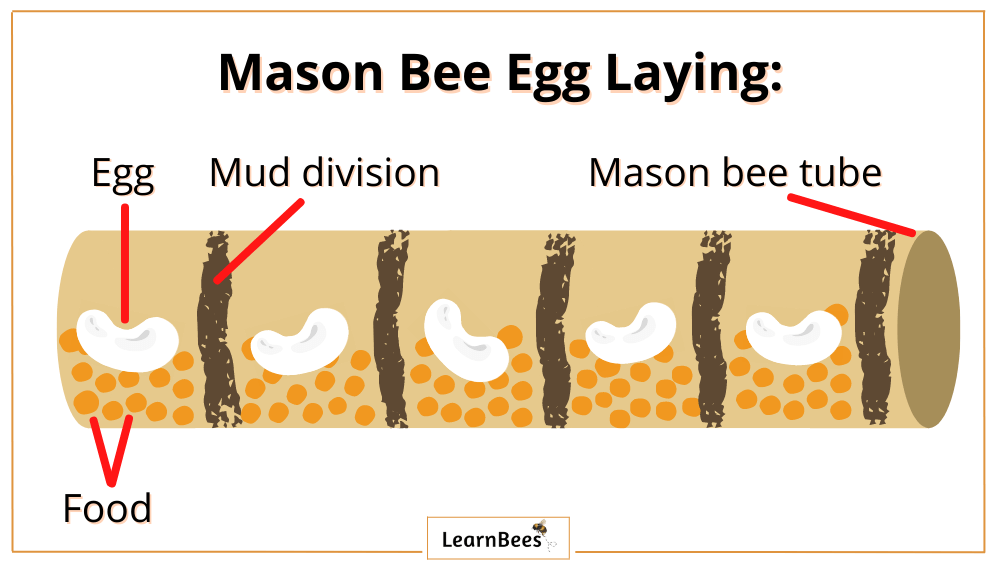
Female mason bees live about four weeks and lay one to two eggs daily. In the wild, mason bees typically lay their eggs in natural cavities such as woodpecker holes. But mason bees also seem just as happy to lay their eggs in artificial cavities such as bee houses.(2)
Now let me address the elephant in the room:
Do mason bees cause damage?
Not at all. Many pest control companies claim that mason bees will damage your home. In actuality, we’ve found no evidence to support this.
For one, mason bees don’t drill into wood like carpenter bees do. Instead, they look for naturally occurring holes made by other insects and animals. Sure, sometimes mason bees will build their nests inside holes on your home’s exterior.
But again:
We’ve found no evidence to suggest that this causes structural or moisture damage to your home.
How to Attract Mason Bees
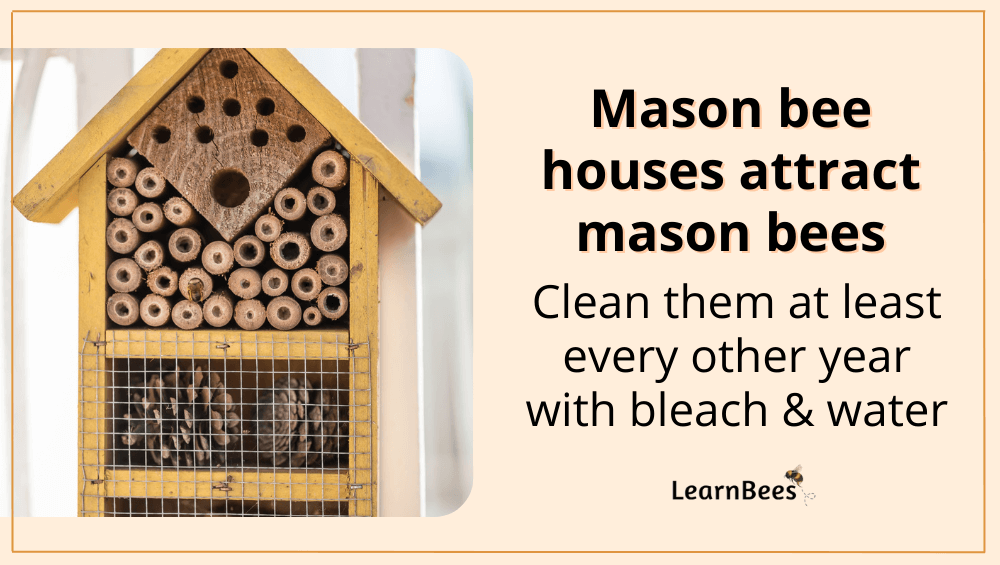
Mason bees are wonderful additions to gardens. These gentle bees are extraordinary pollinators that are fun to watch.
But just a little warning:
Don’t buy mason bees online. Instead, attract local mason bees.
How come, you ask?
Because most mason bees are native and live in a small area. In other words, they live in areas they’ve become adapted to. Once you start shipping them around, you risk putting them in an environment they can’t tolerate.
For example, mason bees in Oregon are used to a totally different climate than the ones in Florida.
And you know what that means:
They could die if thrown into a different climate.
Plus, if you buy mason bees online, you also ship whatever infections and parasites they might have. Not good.
So how do you attract your local mason bees?
In short, you need three things:
- Plenty of flowers
- Nesting tunnels
- Mud
So let’s start at the beginning.
Step 1: Make Your Yard Mason Bee Friendly

Mason bees are hungry in the early spring when they first emerge from their nests. Once temperatures reach around 55°F (13°C), they’ll hatch and go on the hunt for pollen and nectar.
This is where you come in.
For starters, your yard needs to give the bees a warm welcome with flowers that bloom early. Examples include pansies, crocuses, phlox, and spring beauties.
Keep in mind that it’s essential to place your flowers within 200-300 feet of your mason bee house. Unlike honeybees, mason bees won’t fly long distances in search of food. Flowers need to be close.
Now here’s the critical part:
Pick flowers with exposed centers that allow the bees to easily access the nectar and pollen.
For example:

But don’t forget:
You’ll also want to have plenty of flowers that bloom in the late spring and summer. You can get these from your local nursery or plant them from seeds. This is because some species of mason bees emerge in the late spring or summer, depending on your area.
It also doesn’t hurt to make a safe bee watering station by putting rocks in a shallow birdbath and filling it with water. Bees can’t swim, so they need landing perches like rocks or sticks to keep them from falling in and drowning.
Just make sure your water line doesn’t go above the landing perches.
Step 2: Give the Mason Bees a Home
You can make your own mason bee home by drilling plenty of holes into a woodblock. The holes need to be at least five inches deep using a 5/16-inch drill bit. Make sure there are no splinters in the holes.
You can also buy a mason bee house that’s already pre-made.
As for location?
Pick a spot that gets plenty of morning sun. This warms the bees up in the morning and encourages them to start foraging for food early. Mason bees need to be warmed up to fly.
How come?
Because they’re cold-blooded, meaning their bodies don’t retain or regulate heat. They rely on external sources such as sunlight to regulate their body temperatures.(3, 4)

What’s next?
After picking a morning-sun spot, you’ll hang your mason bee house six to seven feet off the ground.
The best places are under an eave of your home, garage, shed, or some other shelter. Your mason bees will appreciate the extra protection from the rain.
Also, securing your bee house to a structure will safeguard your mason bees against high winds. Mason bee houses that dangle can whip around quickly and cause unintentional harm to the bees.
So, in summary:
- Make or buy a mason bee house
- Place the house in a location that gets morning sun
- Preferably hang the house under shelter, 6-7 feet off the ground
Step 3: Provide a Mud Source
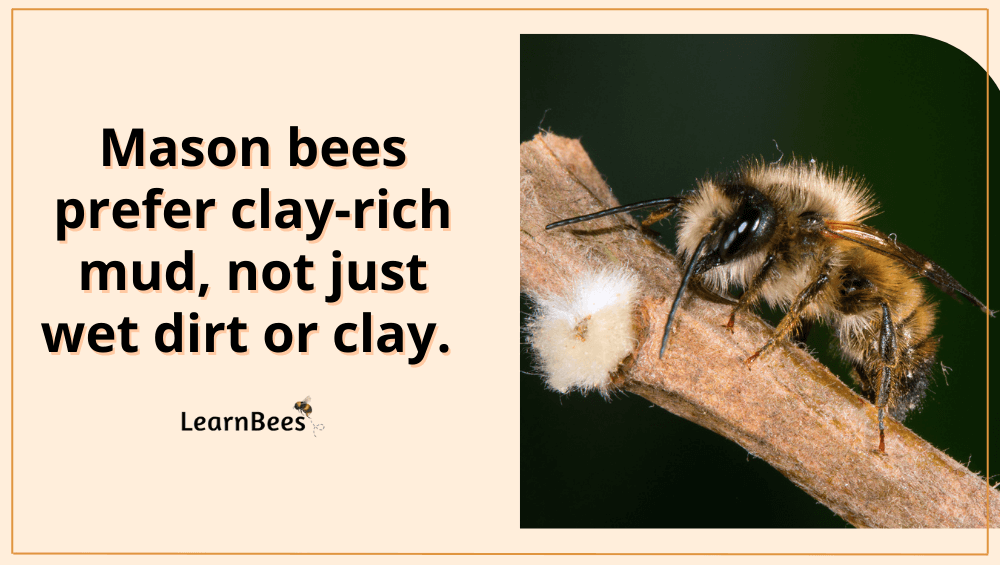
Mason bees like mud, hence why they’re nicknamed ‘masonry bees’ and ‘mortar bees.’
But this is where it gets tricky.
You may have a good mud source nearby. But you also may not.
Mason bees prefer clay-rich mud, not just wet dirt or clay. They also need the mud to be located within 50 feet of their nesting tunnels. With that in mind, you may have perfectly good mud located nearby.
But if you don’t?
You can buy mason bee mud mix instead. It has the correct dough-like texture that the bee is looking for.
From there, you’ll dig a small hole in the ground and place the mud there. The groundwater in your soil will help keep the mud mixture at the proper moisture level. Don’t put the mud in a pot or bowl because it can make the mud too wet or too dry.
Step 4: Be Patient
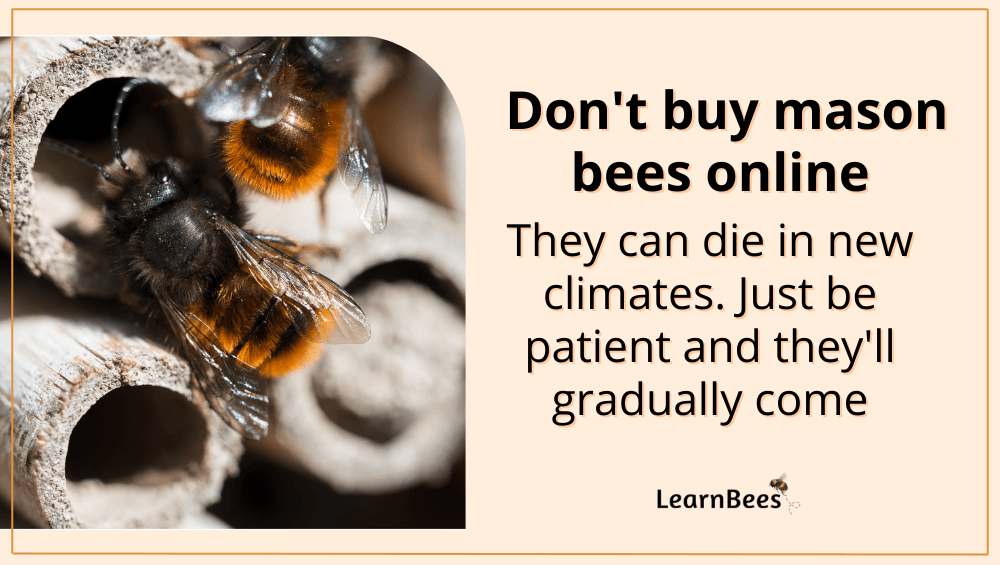
I get it.
You’d love to have a garden full of mason bees immediately.
But the key is patience. You’ll get a few mason bees your first year and a few more the second. You’ll entice more and more mason bees to your yard with each year that passes.
And remember:
We don’t recommend buying mason bees online. This can spread diseases and introduce mason bees to climates they aren’t compatible with. And unfortunately, this can result in their death.
Just follow the steps above, be patient, and mason bees will come.
FAQs on Masonry Bees
- When should mason bee tubes be replaced?
- Are mason bee houses bad?
- Do mason bees sting you?
- What do masonry bees look like?
- What do mason bees pollinate?
- What size holes do mason bees need?
- Where do mason bees go at night?
- Do mason bees destroy your house?
- How long do female mason bees live?
- Are masonry bees protected?
- When should I put out my mason bees?
- Where do mason bees go in the winter?
- How long does it take for mason bees to hatch?
- Do mason bees have predators?
- Where do I buy mason bees?
When should mason bee tubes be replaced?
People often ask, “How do you remove a mason bee tube?” and “How do you care for a mason bee house?”
Good questions.
Mason bee tubes should be cleaned every other year. This will help keep your mason bee population safe from deadly diseases and parasites.
First, ensure that all the bees have emerged from the tubes for the season. Next, submerge them in a bleach-water solution with a 1:2 ratio (one part bleach to two parts water). Allow them to soak for at least 15 minutes.
Finally, submerge the tubes in soapy water for about 5 minutes to get rid of the bleach, then rinse them well. Allow them to dry completely before hanging them out.
Note:
Even if your mason bee houses are cleaned this way, sometimes certain chalkbrood spores will remain present. Chalkbrood is a disease that kills bees. The only way to guarantee against chalkbrood spores is to use replacement tubes every other year.(5)
—> Go back to the FAQs on masonry bees
More to Explore:
Are mason bee houses bad?
Not at all.
But that doesn’t stop media companies from spreading this myth to get attention. They use click-bait titles such as:
- “The Horrors of Mass-Produced Bee Houses”
- “Your Cheap Bee House Is Probably Killing the Bees”
Sounds scary, right?
The only problem is that it isn’t true. Your bee houses aren’t ‘death traps’ responsible for killing bees. Instead, it’s the management of such bee houses that can cause harm.
What do I mean by that?
Basically, you don’t want to go years without cleaning your mason bee house. This is because they can build up infections and parasites over the years. Instead, you either want to clean them or replace them at least every other year.
The idea is simple.
You wouldn’t stay in a home that hadn’t been cleaned in five years. That’s gross. And as for your mason bees? They’re no different. They need a clean environment to lay their eggs in safely.
So whatever material you choose for your mason bee house will be fine as long as you clean or replace it at least every other year. This includes bamboo, wooden blocks, or paper straws.
—> Go back to the FAQs on masonry bees
More to Explore:
Do mason bees sting you?
Curious minds often ask, “Can masonry bees sting?”
Female mason bees can sting, but it’s rare. In fact, I don’t know a single person that’s been stung by a mason bee. These gentle bees aren’t territorial, and they’re a pleasure to have in the garden. You should be fine as long as you don’t poke your fingers in their nests or try to grab them.
And keep in mind:
Male mason bees don’t have stingers. Only the female mason bees do.
—> Go back to the FAQs on masonry bees
More to Explore:
What do masonry bees look like?
There are over 130 species of mason bees in the United States. They each have slight physical differences.
Generally speaking, mason bees are usually fuzzy and smaller than honeybees. Sometimes they have a metallic blue or blue-black coloring. They also sometimes have stripes, like the red mason bee, for example.
—> Go back to the FAQs on masonry bees
More to Explore:
What do mason bees pollinate?
Mason bees are incredible pollinators that are attracted to all kinds of plants.
They’re considered generalists, so they don’t stick to certain blossoms when they forage. They pollinate whatever they find and like. For example, mason bees are avid pollinators of almonds, apples, cherries, blueberries, peaches, plums, and pears.
But more importantly:
Mason bees need flowers that bloom in the early spring. This gives them something to forage on when they emerge.
—> Go back to the FAQs on masonry bees
More to Explore:
- Do Carpenter Bees Pollinate?
- How Long Do Bumble Bees Live?
- Honeybees vs. Bumblebees: How Do They Compare?
What size holes do mason bees need?
The nesting holes for mason bees should be 1/4 to 3/8 inch in width and 5-6 inches long. The hole should be open only on one end. If you’re making your own mason bee house, make sure there are no splinters in the wood.
You can also buy a pre-made mason bee house.
—> Go back to the FAQs on masonry bees
More to Explore:
Where do mason bees go at night?
Female mason bees rest in the front of their nests with their heads facing outward. Male mason bees usually find a safe location in vegetation to protect them from rain or wind.
—> Go back to the FAQs on masonry bees
More to Explore:
- Ground Bees: Are They a Threat to Your Yard?
- Wasps vs. Honeybees: Are They Different?
- Do Bumble Bees Bite?
Do mason bees destroy your house?
Not at all. For starters, mason bees don’t drill into houses or wood like carpenter bees do. They typically nest in pre-existing holes made by other insects or birds.
But if you’re worried about mason bees nesting in cracks in your home, then supply them with mason bee houses for the next season. Once the eggs have emerged in the spring, you can plug the existing holes in your home.
—> Go back to the FAQs on masonry bees
More to Explore:
How long do female mason bees live? How long do masonry bees stay?
Female mason bees typically live about four weeks. Most generations of mason bees will be born sometime between March and May.
—> Go back to the FAQs on masonry bees
More to Explore:
Are masonry bees protected?
In the United States, mason bees aren’t protected by law. But, they’re vital pollinators that shouldn’t be harmed or killed through pest control.
—> Go back to the FAQs on masonry bees
More to Explore:
When should I put out my mason bees?
Once temperatures reach around 55°F (13°C), mason bees hatch and go on the hunt for pollen and nectar. So as a general rule, we recommend having your mason bees out once you notice flowers start to bloom.
That said, mason bees should ideally be left outside to overwinter as they do in the wild. This allows them to decide for themselves when it’s time to emerge.
—> Go back to the FAQs on masonry bees
More to Explore:
Where do mason bees go in the winter?
People often ask:
Do mason bees survive the winter?
Yes. During the winter months, fully-formed adult mason bees hibernate in their cocoons inside the nest. Once daily temps get up to around 55°F (13°C), mason bees emerge as fully formed adults.
Then they’ll spend the next several weeks mating, nesting, and collecting food for their offspring.
If you want to help your mason bees during the winter, place their nest boxes in a dark, unheated garage or shed. Do this in the fall before it gets too cold. Set them back outside once March 1st arrives.
Don’t place the mason bees inside your home or heated area because this can cause them to hatch early.
—> Go back to the FAQs on masonry bees
More to Explore:
How long does it take for mason bees to hatch?
People regularly ask, “How long do masonry bees nest for?” and “How long do mason bee cocoons last?”
After the eggs are laid, mason bee larvae hatch in a few days. They consume the food that has been stored in their cell, which usually lasts them about ten days.
Next, the larva spins a cocoon and pupates. By fall, the insects look like adult bees, but they stay safely inside their cocoons throughout the winter. When the weather warms in the spring, the males emerge first, and the females appear a few days later.
—> Go back to the FAQs on masonry bees
More to Explore:
Do mason bees have predators?
Yes, like all bees, mason bees have a long list of predators.
For example, wasps are one of the most common predators of mason bees. Also, certain birds like woodpeckers will eat mason bees as they emerge in the spring.
The easiest way to deter predators is to store the nest in the unheated garage or shed in the fall. If you have a lot of squirrels and are using a paper product, surround the box with chicken wire to keep them from pulling out the tubes and consuming the contents.
—> Go back to the FAQs on masonry bees
More to Explore:
Where do I buy mason bees?
We actually don’t recommend buying mason bees online. Instead, attract local mason bees to your mason bee houses.
Why?
Because most mason bees are native to a specific region. This is the area they’ve become used to. When you ship them to another area, you risk placing them in a location they can’t tolerate. Unfortunately, this can lead to their death.
For example, mason bees from Washington state are used to a totally different climate than the ones in Florida.
Plus, when you ship mason bees, you can also transport any diseases or parasites that the bees may have. Not good.

